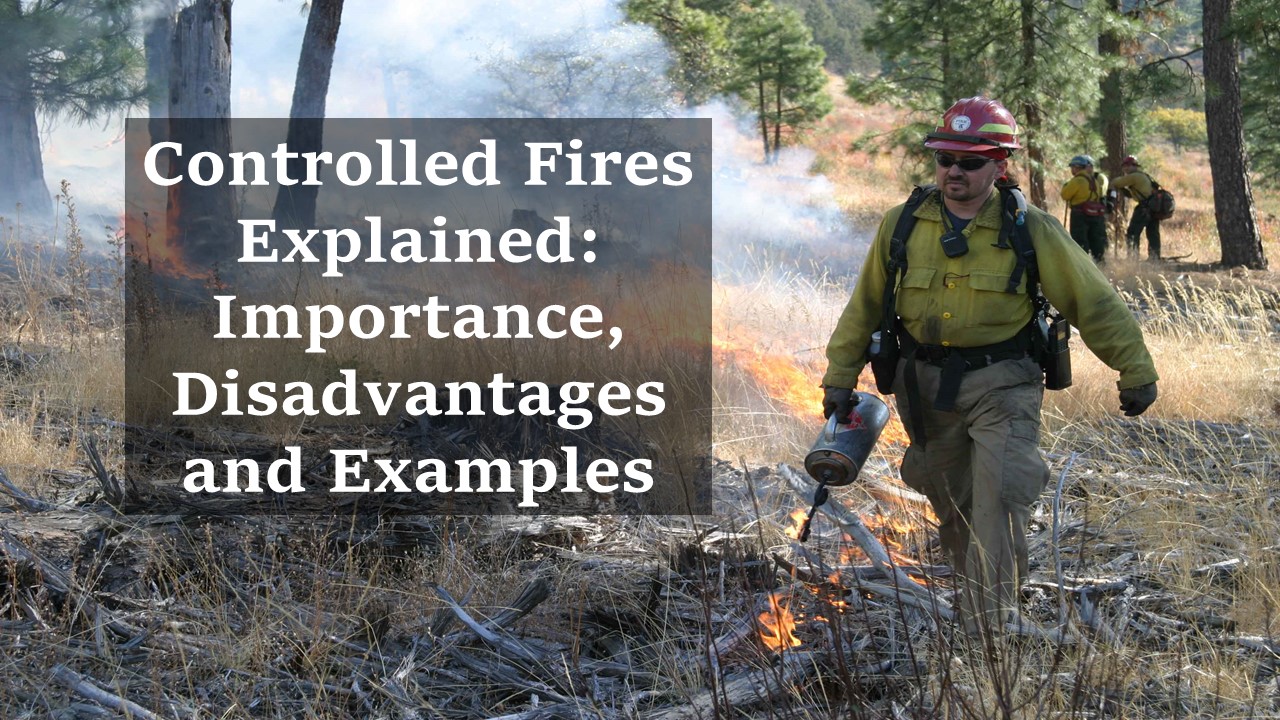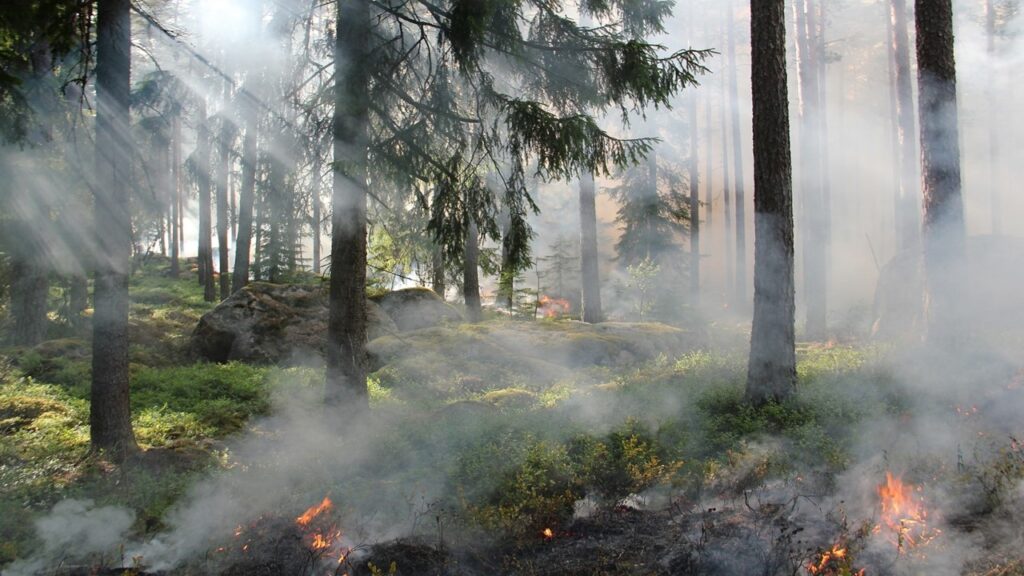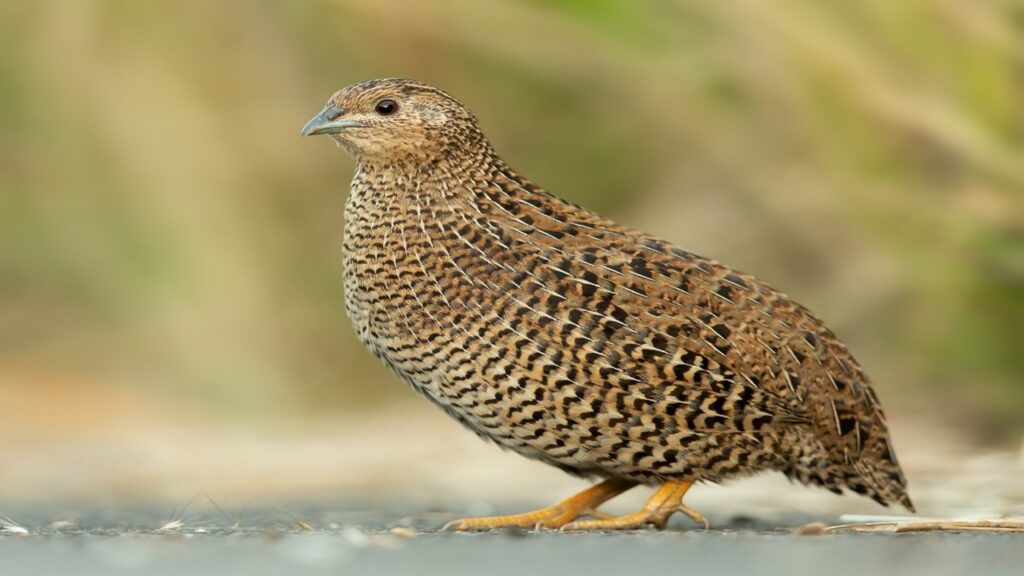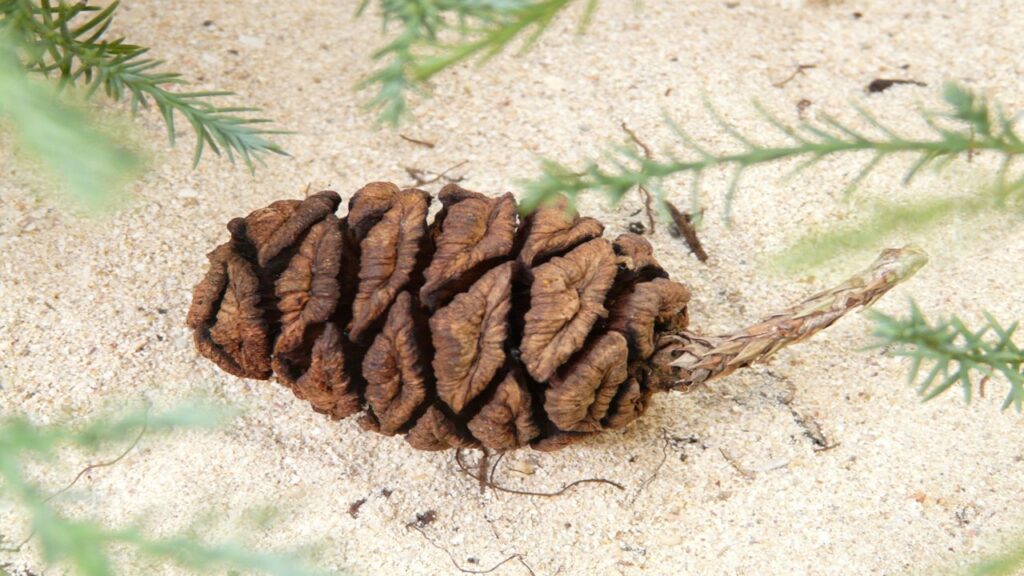Controlled Fires Explained: Importance, Disadvantages

Controlled fires or control burning is when we purposefully set a piece of land on fire. We often do so to maintain the health of the ecosystem and reduce the risk of uncontrolled wildfires. Fire experts carry out the operation under the safest conditions. Controlled fires depend on weather conditions and require a proper plan before we start them.
What is a controlled fire?
We also call a controlled fire a prescribed fire, prescribed burn or controlled burn. So, a controlled fire is when we set an area on fire intentionally. It is quite the opposite of a wildfire which occurs naturally or by accident.
Here, it is a management tool that we use to manage a specific land area. It can be in nature reserves, parks, agricultural lands and wildland fringes. We do it in a prescribed way, that is, using specific guidelines to meet specific objectives.
When we carry out a controlled burn, we can control the intensity of fires. Thus, we can adjust fires as per our management needs.

How to carry out a controlled burn
Basically, a team of certified fire experts carry out the controlled burn. They do so under the safest conditions. Management personnel must also complete a fire management and prescribed burn plan. The plan must meet specific conditions including the
- Specific objectives of the burn,
- Fuel type and size,
- Precise weather conditions (temperature, wind, humidity etc.) and
- Conditions that may suppress the fire.
Broadcast and pile burning
Then we undertake the fire operation either as broadcast burning or pile burning.
Basically, broadcast burning is when we set specific areas on fire at one go.
But when we cannot do that, we have to mechanically cut down trees, remove understory and pile them. Then we light the piles on fire, thus called pile burning.
When to carry out a controlled burn?
Generally, spring and fall are the primary seasons for controlled burning. But it can be at any time deemed necessary like before seed planting.
History of controlled fires
Research shows that with the beginning of farming between 10 200 BC and 2000 BC, humans used fire a lot to manage large areas. In fact, archaeological evidence shows that this practice was common some 7000 years ago in Europe.
Natural wildfires occur frequently in dry regions
As it is, natural wildfires have occurred in dry regions since trees evolved some 350 million years ago. They played an important role in shaping ecosystems and allowing plants and animals to reproduce and grow.
In general, low-intensity fires occur every 5-15 years in dry regions. They clean debris on forest floors and allow sunlight to reach the ground. The burnt materials become nutrients that allow seeds to germinate.
Humans suppressed wildfires
But eventually, the human population grew and we moved closer to regions where wildfires occur naturally. Consequently, we had to suppress wildfires. For example, we cleared vegetation that would encourage wildfires. We killed plants with herbicides and quickly drowned wildfires.
Ecological impacts of subduing natural wildfires
Since the 1960s, our attempts to subdue natural wildfires led to a number of ecological impacts.
- Trees became stunted in forests due to lack of sunlight and nutrients,
- Debris overflowed in forests,
- Several insect species went extinct,
- Invasive plants took over many regions thus preventing the growth of local plants and
- Disease epidemics proliferated.
So, we started to ignite fires in specific regions to mimic natural wildfires.
Why do a controlled burn?
We do controlled burns for a number of reasons.
1. Controlled fires reduce the amount of fuel
When too much fuel (dry leaves, branches, roots etc.) accumulates on forest floors they can induce wildfires. Consequently, we burn them to reduce the amount of fuel in wild lands.
2. Controlled burns prepare sites of seeding and planting
As a matter of fact, prescribed burning is important when we plant certain species. Fire alone can expose mineral soil and kill weeds until seedlings can grow.
3. Controlled fires manage competing vegetation
Controlled fires also remove unwanted vegetation like weeds. They generally prevent primary species from growing. When they die and accumulate, they can also be a source of wildfire. In this way, burning helps to manage competing vegetation.
4. Prescribed fires control insects and diseases
Insects and diseases do a lot of damage to trees and plants. They can weaken and kill seedlings, eat away leaves, shoots and roots. So, the only way to manage them is to use prescribed fires.
5. Controlled fires improve wildlife habitats
Also, controlled fires create a mosaic of habitats. Over the years, forests can become thick and unmanageable. As a result, certain animals cannot live in them.
For example, we often use controlled fires in game-land. In this way, fires open new habitats for deer, quail, turkey and dove that we hunt.

6. Prescribed burning makes regions more attractive
In general, controlled burns also make regions more attractive after a while. Fire removes bushes and debris that were hiding flowering plants.
Likewise, quick growing plants colonize the burnt land and use nutrients in the soil to grow. As they flower, they attract butterflies and animals.
7. Controlled burns improve grazing lands
Additionally, fires remove dead and low-quality grasses in grasslands. They eventually decompose to become high-quality grass rich in protein, calcium and phosphorous. Consequently, controlled burns improve grazing lands making the grass more palatable for cattle.
As an example, farmers in Namibia and Botswana apply prescribed burning in strategic areas during the fire period.
Advantages of controlled fires
1. Allow fire-dependent species to reproduce and grow
As a matter of fact, many species depend on fire to survive. For example, seeds of sequoia germinate only after fire episodes. Likewise, some bark beetles depend on burnt trees for their lifecycles.
So, controlled fires help fire-dependent species to reproduce and grow. This is very important in places where we have disturbed the natural wildfire regimes with fire suppression.

2. Controlled fires maintain the health of natural areas
One very important role of controlled fires is that they maintain the health of natural areas.
Controlled fires kill invasive plants
Over the years, invasive plants can grow in forests and wildlands. More often than not, they compete with local plants for nutrients, sunlight and water. And eventually, they can become dominant thus preventing native species to grow. Consequently, controlled fires kill such invasive species.
Prescribed burning removes diseases
Likewise, disease-causing organisms can proliferate in wildlands, killing plants and animals. Controlled fires also wipe diseases away.
3. Reduce the risk of destructive wildfires
Every year, the amount of leaf litter and branches accumulate on forest floors. As a result, they represent fuel for natural wildfires. So, when we burn the dead materials, we reduce the risk of destructive wildfires.
For instance, in Australia, controlled burning is an integral part of land management. The catastrophic 2019/20 wildfire burnt over 46 million acres of land. So, prescribed burning prevents natural wildfires from destroying infrastructure and property.
4. Controlled fires enrich the soil
Just like wildfires, controlled fires also enrich the soil. Burnt materials decompose and become a rich source of nutrients for seeds to grow.
Disadvantages of controlled fires
1. Kill or injure unintended plants/trees
Sometimes, the intensity of the fire can kill or injure unintended plants and trees. As a result, insects can proliferate in scars and destroy them. Such wood can also lose its market value as timber. At the same time, animals such as birds can lose their nests and habitats.
2. Controlled burns lead to erosion and sedimentation
Controlled fires on steep slopes can be quite challenging as they can lead to erosion during heavy rainfall.
What’s more, ash and soot particle runoff can then flow into rivers and lakes causing sedimentation. Water may then become unfit for consumption or decrease oxygen levels in water bodies. As a result, water creatures may die.
3. Prescribed burning releases carbon dioxide
One of the most problematic effects of controlling burning is that it releases large amounts of carbon dioxide. Carbon locked in trees and plants return back to the air in the form of carbon dioxide.
Today, carbon dioxide is one of the most potent gases behind human-caused global warming. Consequently, more carbon dioxide in the air enhances the issue of global warming.
4. Controlled fires cause health issues
As the fire burns, it typically releases smoke and particulate matter which can cause health problems. This especially affects nearby communities. These materials can irritate the eyes and lead to coughing and other respiratory problems.
Types of controlled fires
In general, there are three types of controlled burns: head fires, back fires and flank fires.
Head fires
Head fires are relatively high-intensity burns that move through fuel at a high speed. They typically burn upslope or with the wind. Head fires move quite quickly with intense heat and long flames.
We start the burn in strips to speed up the burning process and to provide the desired intensity.
Backfires
Here, backfires principally burn downslope or against the wind. They burn with lower intensity and lower flames. Backfires also move through fuel at a slower speed. As a result, it is easier to control backfires.
Flank fires
Flank fires burn perpendicular to the wind direction or into the wind. We usually use them to supplement other burning techniques like backfires. They burn faster than backfires and the flames are higher as well.
Importance of controlled fires
Basically, prescribed burning is an important and cost-effective way to manage wild and agricultural lands. It helps us to eradicate disease and weeds. Control burning also permits us to maintain certain historic sites. An example is the open grasslands at Saratoga National Historic Park in New York.
Today, especially, ‘mega-fires’ are becoming common. Mega-fires are wildfire events that go beyond our capacity and resources to fight them. With climate change, they will only get worse. So, controlled fires help to decrease their occurrence while allowing fire-dependent species to survive.

Pingback: Snow Avalanches Explained: Types, Causes and Examples - Yo Nature